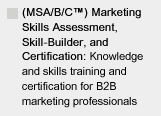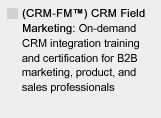MAKE SURE YOU CONTINUE TO RECEIVE EACH ISSUE OF TUESDAY MARKETING NOTES—CLICK HERE TO RENEW YOUR FREE SUBSCRIPTION
Developing Marketing Content Salespeople Actually Use
By Ardath Albee, CEO, Marketing Interactions, Inc.
Marketers spend a lot of time creating content, messaging and resources to catch the attention of prospective customers. Research shows that salespeople spend an inordinate amount of time recreating that collateral in ways that work for them.
What a colossal waste of time that salespeople could be spending face-to-face with those buyers.
I was thinking about this today as I worked on planning a site map for a client's new website. I want to keep the content as flat as possible, limiting the clicks, so I kept turning the context around and around to determine the best way to do this for my client's complex product.
Finally, I stopped and reassessed. With a new product, one of the biggest considerations is intuitive context and relevance. Immediate recognition of what the website is about and why they should care.
Sales tools need the same kind of directed focus. Salespeople are becoming the ultimate experts in consultative conversations - at least for complex sales. This transition is critical because it's likely that the value they bring is what differentiates your company and product from all the other options available to that buyer.
This same principle should apply to your online website content, digital nurturing and email communications. Your customers likely don't think - "Gee, I need a Whiz Bang 5000." From their perspective, the equivalent of a Whiz Bang 5000 is probably closer to "What do I need to solve THIS problem and get THIS outcome?"
Marketing content is usually designed for the front end of the sales cycle. In other words, it's designed to catch attention, generate interest and engage your prospects to reach the conclusion that your company provides a viable option for the issue they're looking to address.
Sales has to start from that point and convince the prospect that what they've been lead to believe is true and that selecting your solution is the best possible choice. Salespeople have the task of exposing the journey the buyer will take to get to the outcome they want and of validating that their company can actually deliver as promised.
This means that if marketing wants sales to use the collateral they create, they need to think beyond sales-ready leads and develop content that helps sales get the buyer to make the transition to customer.
Because each buyer is different, it's imperative that marketing doesn't focus on one-size-fits-all content, but develops content that addresses the various problems, challenges and issues their customers face. This also means that marketing has to know customers...intimately. They need to know them by role, industry and top-of-mind priorities. They need to know how each of those factors impacts the problem/solution scenarios their products address.
And they need to think small pieces that salespeople can combine seamlessly into any array they need to personalize the collateral for a specific customer.
Some examples are:
• Solution Story Slides - consider creating mini-decks that have 5-7 slides that address a specific problem/solution scenario. If your product has a lot of features, create a slide for each one so salespeople can select only the information that's pertinent to a specific opportunity. Less can definitely be more.
• Validation Slides - create them by industry, customer size or however your customer segments break down. People want to know how other companies solve similar problems and see the successful outcomes. These kinds of mini stories help them to believe that the outcome they want is actually viable.
• Thought Leadership Articles - a variety of education and expertise articles that can be included in sales collateral. Make sure you have quote snips and key points that can be extracted easily for use on slides or in email messaging. Aim for a 500 word article, two or three key points, and several email scripts that are easily personalized. And make sure they're written from the customer's perspective.
One of the reasons I used slides in the above examples is that it's easy to copy and paste slide material into a Word doc, or even select from a slide library and then create a PDF. Not to mention creating a relevant meeting presentation deck.
The key to all of this is collaborating with your salespeople. For each sale, look at the collateral they used to close the sale. Learn what they would've liked to have, but didn't, that might have enabled them to shorten the sales cycle. And look for what they used that didn’t work so well. What set them back and made them work harder to keep the momentum moving forward with the buyer?
Yes, the answers will vary widely based on the individual salesperson's style, industry and product focus. That's why I promote the use of small pieces. They can be combined in a number of ways, attention spans are shorter than ever and no two sales will be exactly the same.
Take an inventory of the collateral marketing has made available for sales. If that content is made available via a web interface, utilize analytics to show you who’s accessing which materials. Although this can also be tricky as salespeople will store them on their individual machines and combine them in different ways. Any resource that’s not being accessed should be re-evaluated and revised or discarded. Clear out the clutter.
Ask your salespeople to submit copies of collateral that’s worked successfully and add them to your sales tools library.
Evaluate the ways in which you make your sales collateral available. Is it a random search process that becomes a time-consuming archaeological dig, or have you presented a navigation that’s built on the ways your salespeople think about collateral and answering customer needs? In this instance, sales is the customer marketing is serving.
By creating a sales tools library in this manner, you can lessen the time salespeople spend on collateral creation and keep your brand message on track. This outcome won't happen in a vacuum. Sales and marketing will need to actually talk to each other. However, the time savings is worth it. So are shortened sales cycles and more engaged customers.
Ardath Albee (Ardath@marketinginteractions.com) is a B2B Marketing Strategist and the CEO of her firm, Marketing Interactions, Inc. She helps B2B companies with complex sales create eMarketing strategies that use contagious content to turn prospects into buyers. Ardath was recently selected as one of the Top 20 Women to Watch in Sales Lead Management. Among her clients are Cisco, Tyco Electronics, Adobe, BMC Software, funeralOne and Sykes, Inc. Ardath is the author of eMarketing Strategies for the Complex Sale (McGraw-Hill). Read her blog at http://www.marketinginteractions.typepad.com/ and follow her on Twitter at @ardath421.







